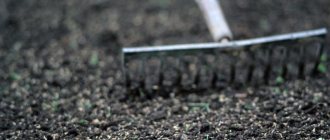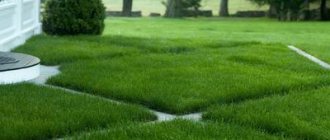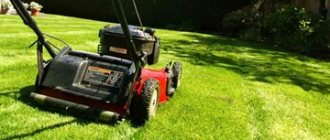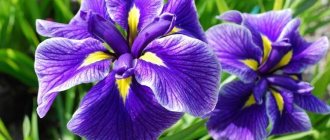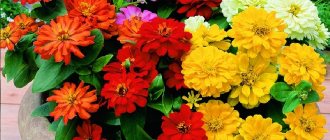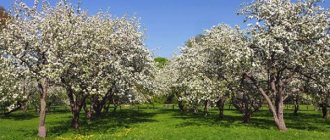Before laying a lawn, the soil is dug up and treated with special weed killers. However, their seeds are spread by the wind, birds, animals, etc., so they still appear despite preventive measures. This ruins the appearance of the lawn. In addition, weeds are more resistant to adverse weather conditions and trampling, so over time they destroy lawn plants. There is not always time for weeding, and it is also a rather labor-intensive process. Lawn grass will help correct the situation by displacing weeds.
Bentgrass
Grass is considered the best solution for people who do not want to mow their lawn frequently. The bentgrass grows very slowly in height, but quickly expands in width. Thanks to this, it creates a dense, dense carpet, preventing the germination of weeds. Already in the 2-3rd year, the grass completely occupies a leading position and expels other plants from the area.
To get a good result, it is advisable to sow bentgrass in spring or autumn. She feels best in lacy partial shade. In open sunny areas, the grass quickly fades, and in the shade it forms bald spots. To get a uniform green canvas, it is worth sowing seeds at the rate of 150 g per 100 m2. The cost of 1 kg of seeds is about 850 rubles.
Bentgrass can also be propagated vegetatively. To do this, the shoots are cut into cuttings 5 cm long. It is important that they have at least 2 internodes. The cuttings are planted at a distance of about 10 cm from each other. The seedlings are sprinkled with earth and compacted. This method is good for covering bare areas.
The nuances of proper planting and care of herbs that crowd out weeds
The main task of the gardener is to create the most dense “green carpet” and maintain it in this condition. The approximate seed consumption in this case is about 40 g/m². The prepared area is marked with a rake, “drawing” longitudinal furrows at intervals of 2–3 cm, first in one direction, then perpendicularly. The result is a “lattice” with small cells. Seeds are sown in furrows manually or using a special seeder. The second option provides a more uniform fit.
When working with the lawn, it is better to use fan rakes - they are more convenient for marking the area when planting, and for removing fallen leaves and dry grass
Having completed planting, they rake over the lawn again, embedding the seeds into the soil. The substrate is watered moderately and compacted with a garden roller or any heavy cylindrical object with a flat surface is rolled over it. Practice shows that in compacted, moist soil, lawn grass sprouts more vigorously and begins to grow faster.
A lawn seeder is a convenient device that allows you to sow seeds evenly
To maintain lawn density, you must:
- Trim the grass regularly. This stimulates lateral branching, activating dormant buds.
- Create “patches” by sowing “bald spots” in place of frozen plants with fresh seeds each time after winter.
Bald spots in your lawn need to be filled regularly, otherwise the weeds will do it for you.
Video: how to plant a lawn correctly
Red fescue
A very beautiful grass that crowds out weeds. It creates a powerful root system, drowning out other plants. Fescue forms strong shoots underground that quickly spread to cover bald spots. The grass forms dense turf. The leaves are narrow, closely spaced, creating a uniform carpet.
The main benefits of red fescue:
- resistance to low temperatures;
- rapid recovery after trampling;
- loyalty to low mowing.
The grass is used as a monoculture or added to mixtures. The cost of red fescue is low - only 250 rubles. for 1 kg.
Site preparation
Before planting grass for your lawn, you need to prepare the area. Markings are made on it, after which the weed roots are removed. The procedure is repeated several times every two weeks. Then the ground needs to be leveled.
Treatment with herbicides - chemicals aimed at destroying certain plants - will help prevent the spread of weeds. It is best to use herbicides in the spring on young seedlings.
The lawn is treated with the following types of herbicides:
- All action. Such drugs destroy all types of vegetation on the lawn. They are applied to the leaves of plants, which gradually dry out. The effect of such substances extends to both the above-ground part and the root system. The most effective continuous action herbicides are Agrokiller and Tornado.
- Selective influence. These substances affect only certain types of grass and do not harm garden crops and lawn grass.
Important! After applying herbicides, the weeds will die within 2 weeks, after which the grass is collected and removed from the site.
Meadow bluegrass
In the fight against self-seeding, bluegrass noticeably loses to fescue and bentgrass. It completely displaces weeds only in the 4th year of life, reaching maturity. Before this, shoots may be sparse and weak. Despite this disadvantage, bluegrass is often used as a lawn grass. The main reasons to sow a plot with it:
- grows quickly;
- self-pollinates, simplifying care;
- adapts to climate, soil characteristics;
- resistant to trampling;
- mows evenly, forming a dense, uniform lawn;
- turns green immediately after the snow melts.
Bluegrass is a lawn grass that is not afraid of strong winds and frosty winters. It is very rarely affected by pests and does not get sick. The cost of 1 kg of seeds is about 830 rubles.
Weeds growing on the lawn
Various weeds are found on decorative green coverings, but all of their representatives have an amazing degree of vitality and resistance to adverse environmental factors.
The following weeds on the lawn bother gardening enthusiasts the most:
- Clover. It is distinguished by the trifoliate shape of the leaf blades, sometimes there are four leaves. The color of the harmful crop is white or pink, the aroma is quite pleasant. Weeds are undemanding to growing conditions, especially in depleted soils, where there is a nitrogen deficiency and watering is extremely rare. Seed distribution occurs quite quickly; they are able to germinate anywhere.
- Dandelion. The tenacious plant stands out for its bright yellow flowers and long and strong roots. With the arrival of cold weather, the above-ground part dies off, and in the spring new leaves appear. The difficulty of controlling this crop lies in the ease of spread of weightless fluffy seeds carried by the wind. To reduce the likelihood of dandelion appearing on the lawn, preventive measures should be taken every year. It is advisable to remove the weed even before the seeds form.
- Bluegrass. At the initial stage of development, the annual plant is similar to lawn grasses. In the future, it produces long spikelets, which pose a problem for summer residents. The weed is distinguished by its ability to adapt to external conditions. You can also fight it mechanically, simply by removing it by the roots. Bluegrass loves compacted areas of green lawns.
- Medium chickweed (woodlice). The weed most often appears in shaded areas with high humidity, and is quite difficult to get rid of. The reproduction process occurs at tremendous speed - one plant produces up to 15 thousand seeds per year. In addition, the creeping shoots of the weed can also take root, conquering a large area on the lawn. The active growing season of woodlice, another name for chickweed, lasts a long time, from spring to late autumn. The germination period of seeds in soil is 5 years.
- White pigweed (common). Weed plants grow solitarily, have wide, soft leaves of a light green color, and spike-shaped inflorescences. It reaches a height of 2 m. A huge number of seeds (200-700 thousand) per season significantly complicates the process of getting rid of this crop. It is noteworthy that seedlings have their own characteristics regarding survival: some specimens begin to germinate as soon as they fall into the ground, others - the next year, and others - after 2 years. The annual plant surprises with its ability to survive even on technically developed soils. On the erect stem of quinoa, large triangular leaf plates are located opposite. There is a whitish coating on their surface.
Clover
Dandelion
Microclover
A very popular solution for home lawns. Microclover is a dwarf variety of creeping shamrock. It grows very slowly, so it does not need frequent mowing. Small-leaved clover quickly greens up the area. This is a grass that gradually kills absolutely all weeds. Miniature trefoil is rarely added to mixtures because it overpowers other herbs. The main advantages of the variety:
- drought resistance;
- unpretentiousness to fertilizing and watering;
- low mowing tolerance;
- high resistance to trampling;
- landscaping all year round.
Microclover grows in one place for about 8 years. It is sown at the rate of 100 g of seeds per 100 m2. Miniature trefoil is an expensive herb. The cost of 1 kg of seeds is about 1,700 rubles.
Planting a lawn
After control clearing of the weed, you can begin sowing lawn grass. Let's look at this procedure step by step:
- Level and compact the top layer of soil.
- Scatter the seeds. This should be done in 2 stages, in 2 different directions. For larger plots, it is more advisable to use a special seeder. Small areas are sown by hand. On average, 35-45 grams of seeds are consumed per 1 square meter.
- It is easy to level the surface with a rake.
- Cover the area with a small layer of peat mixture - 1-2 centimeters.
- Press the seeds into the soil using a roller or balloon.
- Scatter a layer of straw or compost on top.
- Wet the area with a hose using a spray nozzle.
- After the seeds germinate, water the lawn.
Ryegrass
If you are wondering what kind of grass looks beautiful, requires minimal care and fights weeds, then it is ryegrass. The culture is widely in demand in the design of lawns. The stems are thin and smooth, the leaves are narrow. The grass remains soft and silky even after mowing.
Ryegrass has a very developed root that penetrates deep and extracts nutrients. Thanks to this, it displaces weeds from the area. If you add nitrogen to the soil, the green mass will quickly grow. At the same time, ryegrass behaves very aggressively towards other plants.
The culture is included in many mixtures. It is suitable for decorating not only home lawns, but also various sports fields. The price of 1 kg of seeds is about 1000 rubles.
Diseases and pests
| Powdery mildew Ways to fight:
| |
| Red threading Ways to fight:
| |
| Mosses, lichens Ways to fight:
|
Grass mixtures to displace weeds
Although monocultures give positive results, very often you have to tinker with them a lot. Grass mixtures are another matter. Thanks to skillfully selected crops, it is possible in a short time to create an almost ideal lawn, on which there is no room for weeds. Grasses of all levels, with different types of root systems, create a dense, thick carpet that is difficult to break through. Let's look at the most popular grass mixtures for weeds.
Canada Green
One of the most unpretentious mixtures to grow. Canada Green consists of bluegrass, fescue, and different varieties of ryegrass. Seeds have 95% germination rate. They quickly germinate and strengthen. The grass mixture tends to grow. Its main advantages:
- withstands temperature range from -40 to +40 °C;
- creates dense turf, does not give weeds a chance to germinate;
- green all year round;
- maximum shoot height – up to 15 cm;
- self-propagates, covering bald spots;
- Suitable for all types of soil.
In the first years after sowing, weeding of isolated weeds may be necessary. In the 2-3rd year they disappear completely. The cost of lawn grass starts from 300 rubles. for 1 kg.
Lilliputian
The grass mixture creates a low but very dense carpet that displaces any weeds. The composition includes carefully selected meadow herbs brought from Canada and Europe. Their main feature is their slow growth, unpretentiousness to the soil, and adaptability to any climatic conditions.
The Lilliput mixture consists of 7 components: common red fescue, red Mystic fescue, hairy fescue, modified fescue, as well as bluegrass and thin bentgrass. This composition ensures the rapid formation of dense turf and accelerated interweaving of rhizomes, so that weeds cannot break through either from above or from below. The main advantages of the grass mixture:
- develops well in the sun and shade;
- resistant to low temperatures;
- tolerates prolonged drought;
- resistant to trampling.
You can plant such grass both near a residential building and near administrative buildings. In the first year of life, she does not require a haircut. A small drawback of Lilliput is its miniature seeds. Because of this, the volume of grass mixture required for sowing increases, and with it the cost of the lawn rises. Sowing is carried out at the rate of 35 g of seeds per 1 m2. But the lawn pays for itself by reducing mowing costs. The price of 1 kg of mixture is about 500 rubles.
Reviews from gardeners
Tanya-Tanya, Russia
Ryegrass is a must in all lawn seeding mixtures. The grass grows well, does not freeze in Siberian winters, and does not give any chance to weeds.
Source: otzovik.com
Curl
Bentgrass shoots. No more than 15 cm in height, very soft, light green, almost no spikes. At the same time, it quickly spreads, forming a dense turf.
Source: braverkerl.www.nn.ru
Kinds
Since weed control is of paramount importance, weeds should be selected for planting in which this ability is most pronounced.
Weeds not only disfigure the lawn, they also suppress cultivated plants. This is done both indirectly - through the selection of moisture and nutrients, and directly - through toxic phytoncides secreted by the roots (wheatgrass, bindweed).
Neckless chicken. Description, features, care and price of bare-necked chickens
Lawn grasses control weeds by creating dense turf with intertwined roots. Such protection does not allow the alien to settle and develop its own root system. This works best with a number of lawn grasses, the characteristics of which are given below.
Meadow bluegrass
One of the most common lawn grasses. Characterized by early germination and rapid growth. It tolerates loads well due to its dense turf and ability to recover quickly.
Resistant to adverse weather factors - frost, strong wind.
Many varieties have been bred based on meadow bluegrass, here are the most common:
- Dolphin;
- Connie;
- Compact
Some varieties live up to 10 years.
Red fescue
Grass with increased drought resistance. At the same time, in conditions of lack of moisture, it retains the ability to effectively counteract weeds, creating dense turf with a rooting depth of up to 20 cm. Fescue is not afraid of the lack of light - it actively develops shaded areas.
Running bentgrass
Another actively growing grass that aggressively crowds out weeds. It is able to settle on soil with almost any composition, as long as the area is well lit by the sun.
Bentgrass
Needs regular, abundant watering, especially in the first year of life. Typically, bentgrass is cut 4 times per season.
Microclover
Microclover is the name given to the Pipolina clover variety, created on the basis of white creeping clover. The prefix “micro” is due to the small size of the leaves and height - 5 cm. All types of clover are so aggressive in developing the territory that they themselves are considered a rather dangerous weed. When planting them on the lawn, you should provide protection to flowers and other crops with a weak root system.
Clover has other advantages:
- the crop is forage - suitable for pastures;
- blooms twice a season with beautiful ball-shaped buds (Pipolin has white flowers);
- cultivation on slopes is possible: a strong and dense root system keeps the soil from sliding and collapsing;
- is content with occasional watering and does not require feeding;
- improves the soil, enriching it with nitrogen (a waste product of special bacteria living on the roots).
Disadvantages of clover:
- when wet - slippery: walk with caution;
- actively attracts bees and other stinging insects;
- does not allow treatment with even the most gentle herbicides: weeding (sometimes weeds still appear) is carried out only by hand.
Ryegrass
Warm-loving grass.
It has strong shoots and a very dense root system, due to which it is highly resistant to trampling and is therefore an indispensable component of sports lawns. These same qualities provide resistance to weeds. The disadvantage of this plant is its sensitivity to cold. In extremely harsh winters, ryegrass can freeze.
Soil preparation
The next step is preparing the soil for the lawn:
- clay soil is fertilized with vermicompost or humus;
- lime is used to reduce soil acidity;
- In the spring, nitrogen fertilizer is applied, allowing the plants to increase their green mass;
- in autumn, compositions based on phosphorus and potassium are used;
- after applying fertilizers, the soil is loosened, its surface leveled and watered;
- the soil is thoroughly compacted using a heavy roller.
After carrying out the necessary procedures, the soil under the lawn should be left for a week. During this period, soil shrinkage will occur. Sprouting weeds must be eliminated.
Dicentra
The upper part of this plant with heart-shaped buds will not give the summer resident much trouble in caring for it - but the powerful rhizome and densely spaced foliage will prevent any grass from appearing between the plants. If you want dicentra to grow well in your garden, plant it in well-drained, well-moistened soil. The place can be either sunny (in this case, the dicentra will bloom earlier) or with partial shade (the buds will appear later, but will stay on the plant for a long time).
- Growing dicentra in the garden
Everyone knows this amazing plant with clusters of hearts hanging from the branches. But how to grow it?
Lily of the valley
The “grabbing” properties of lily of the valley have long been known to many gardeners. This cute-looking plant is capable of displacing all its neighbors from the flowerbed and remaining to reign there in splendid isolation. Therefore, the flower needs to be thinned out from time to time. Lily of the valley especially likes moist soils, as well as partial shade and shade. It should be grown with great care in areas where children are frequent guests, because this plant is poisonous from roots to flowers.
- May lily of the valley - plant or get rid of?
A variety of flowers coexisted peacefully in my flower garden for many years. But three years ago I planted lilies of the valley in it. Since then the problems started...
Ground cover plants
Small periwinkle, sedum, loosestrife, isotoma, aubrieta and other, other, other ground cover plants with small or no flowers can grow anywhere (even in the seams between the slabs of the path), they require little attention, but they grow quickly. The only thing that needs to be done is to systematically monitor their green and floral carpet under your feet. Otherwise, there may simply be no other plants left in the flower garden. Including weeds.
- Unquestioned groundcovers - the best plants for garden paths
6 Ground Cover Plants You Can Walk On.
